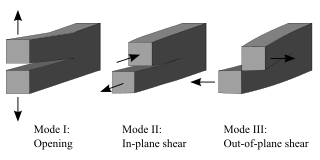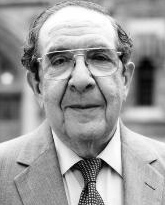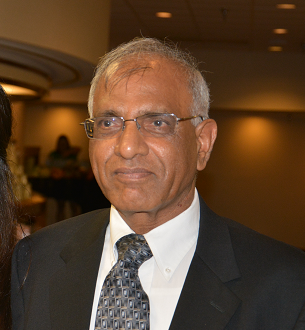Related Research Articles

Grigory Isaakovich Barenblatt was a Russian mathematician.
The field of strength of materials typically refers to various methods of calculating the stresses and strains in structural members, such as beams, columns, and shafts. The methods employed to predict the response of a structure under loading and its susceptibility to various failure modes takes into account the properties of the materials such as its yield strength, ultimate strength, Young's modulus, and Poisson's ratio. In addition, the mechanical element's macroscopic properties such as its length, width, thickness, boundary constraints and abrupt changes in geometry such as holes are considered.
Solid mechanics is the branch of continuum mechanics that studies the behavior of solid materials, especially their motion and deformation under the action of forces, temperature changes, phase changes, and other external or internal agents.

Fracture mechanics is the field of mechanics concerned with the study of the propagation of cracks in materials. It uses methods of analytical solid mechanics to calculate the driving force on a crack and those of experimental solid mechanics to characterize the material's resistance to fracture.

Ronald Samuel Rivlin was a British-American physicist, mathematician, rheologist and a noted expert on rubber.
The Timoshenko Medal is an award given annually by the American Society of Mechanical Engineers (ASME) to an individual "in recognition of distinguished contributions to the field of applied mechanics."
Bernard Budiansky was an American scholar in the field of applied mechanics, and made seminal contributions to the mechanics of structures and mechanics of materials. He was a recipient of the Timoshenko Medal.
John W. Hutchinson is the Abbott and James Lawrence Research Professor of Engineering in the School of Engineering and Applied Sciences at Harvard University. He works in the field of solid mechanics concerned with a broad range of problems in structures and engineering materials.
George Rankin Irwin was an American scientist in the field of fracture mechanics and strength of materials. He was internationally known for his study of fracture of materials.
Paul Mansour Naghdi was a professor of mechanical engineering at University of California, Berkeley.
Alan Needleman is a professor of materials science & engineering at Texas A&M University. Prior to 2009, he was Florence Pirce Grant University Professor of Mechanics of Solids and Structures at Brown University in Providence, Rhode Island.

Thomas Joseph Robert Hughes is a Professor of Aerospace Engineering and Engineering Mechanics and currently holds the Computational and Applied Mathematics Chair (III) at the Oden Institute at The University of Texas at Austin. Hughes has been listed as an ISI Highly Cited Author in Engineering by the ISI Web of Knowledge, Thomson Scientific Company.

Zdeněk Pavel Bažant is McCormick School Professor and Walter P. Murphy Professor of Civil Engineering and Materials Science in the Department of Civil and Environmental Engineering at Northwestern University's Robert R. McCormick School of Engineering and Applied Science.
Daniel Charles Drucker was American civil and mechanical engineer and academic, who served as president of the Society for Experimental Stress Analysis in 1960–1961, as president of the American Society of Mechanical Engineers in the year 1973–74, and as president of the American Academy of Mechanics in 1981–82.

Junuthula N. Reddy is a Distinguished Professor, Regent's Professor, and inaugural holder of the Oscar S. Wyatt Endowed Chair in Mechanical Engineering at Texas A&M University, College Station, Texas, USA.[1] He is an authoritative figure in the broad area of mechanics and one of the researchers responsible for the development of the Finite Element Method (FEM). He has made significant seminal contributions in the areas of finite element method, plate theory, solid mechanics, variational methods, mechanics of composites, functionally graded materials, fracture mechanics, plasticity, biomechanics, classical and non-Newtonian fluid mechanics, and applied functional analysis. Reddy has over 620 journal papers and 20 books and has given numerous national and international talks. He served as a member of the International Advisory Committee at ICTACEM, in 2001 and keynote addressing in 2014.[2][3]
Zhigang Suo is the Allen E. and Marilyn M. Puckett Professor of Mechanics and Materials in the Harvard School of Engineering and Applied Sciences. His research centers on the mechanical behavior of materials and structures.
Raymond William Ogden is a British applied mathematician. He is the George Sinclair Professor of Mathematics at the Department of Mathematics and Statistics of the University of Glasgow.
John W. Rudnicki is an American engineering professor.

Max Erich (Eric) Reissner was a German-American civil engineer and mathematician, and Professor of Mathematics at the Massachusetts Institute of Technology. He was recipient of the Theodore von Karman Medal in 1964, and the ASME Medal in 1988

Lallit Anand is the Warren and Towneley Rohsenow Professor of Mechanical Engineering at the Massachusetts Institute of Technology (MIT). His research focuses on solid mechanics and large deformation plasticity theory. He has received numerous awards and accolades for his significant contributions to the field of applied mechanics and mechanical engineering.
References
- 1 2 Who's who in Frontier Science and Technology. Vol. 1. 1984. p 608
- ↑ Who's who in Frontiers of Science and Technology, 1985. p. 423
- ↑ James R. Rice: Mallinckrodt Professor of Engineering Sciences and Geophysics at seas.harvard.edu, 2017. Accessed 2017-09-17.
- ↑ Rice (1967, i)
- ↑ J.R. Rice, acceptance speech, Timoshenko Medal, 1994.
- ↑ Tze-Jer Chuang and John Rudnicki, Biography of James R. Rice, iMechanica
- ↑ Harvey Prize 2021
- ↑ "Fellows". Royal Society. 2015-12-01. Retrieved 2016-03-11.
- ↑ Foreign member of the Royal Society